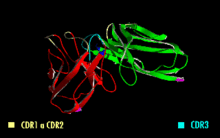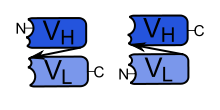- scFv-Fragment
-
scFv-Fragmente, auch scFv-Antikörper (von engl. single chain variable fragment), sind künstlich hergestellte Antikörperfragmente, die die Antigen-erkennenden variablen Domänen der leichten und der schweren Kette eines klassischen Antikörpers kovalent verbinden. Beide Domänen sind über einen kurzen Linker, der in der Regel aus einer Sequenz der Aminosäuren Glycin oder Serin besteht, mit Hilfe molekularbiologischer Methoden miteinander verbunden. Mit Ausnahme der an die fehlende Fc-Einheit geknüpften und über eine Aktivierung des Komplementsystems vermittelten Zytotoxizität bleiben die wesentlichen Eigenschaften eines Antikörpers, insbesondere seine Selektivität und seine Affinität erhalten. scFv-Antikörper finden experimentell in der Durchflusscytometrie und in der Immunohistochemie Anwendung. Darüber hinaus werden derzeit einige scFv-Antikörper, wie beispielsweise Pexelizumab und CC49-scFv, sowie ein bispezifischer scFv-Antikörper (Blinatumomab) in klinischen Studien für eine mögliche therapeutische Anwendung untersucht.[1]
Einzelnachweise
- ↑ Holliger P, Hudson PJ: Engineered antibody fragments and the rise of single domains. In: Nat. Biotechnol.. 23, Nr. 9, September 2005, S. 1126–1136. doi:10.1038/nbt1142. PMID 16151406.
Weiterführende Literatur
- Lennard S: Standard Protocols for the Construction of scFv Libraries. In: Springer protocols. 2001. doi:DOI 10.1385/1-59259-240-6:059.
Wikimedia Foundation.


